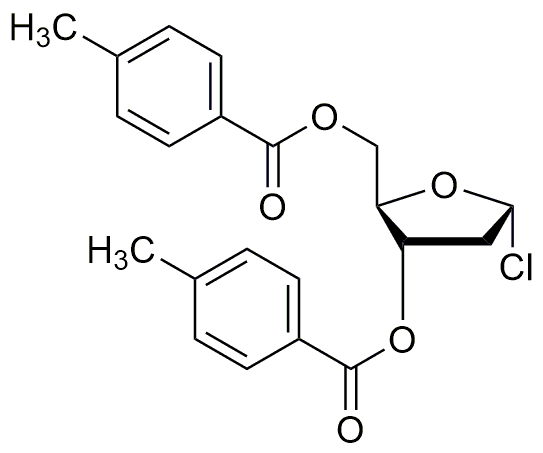2-Deoxy-3,5-O-di-p-toluoyl-a-D-erythro-pentofuranosyl chloride is widely utilized in research focused on:
- Nucleoside Synthesis: This compound serves as a key intermediate in the synthesis of modified nucleosides, which are crucial for developing antiviral and anticancer drugs.
- Drug Development: Its unique structure allows researchers to create prodrugs that enhance the bioavailability of therapeutic agents, improving patient outcomes in treatments.
- Biochemical Research: It is used in studies involving glycosylation reactions, helping scientists understand carbohydrate interactions in biological systems.
- Diagnostics: The compound can be utilized in the development of diagnostic tools, particularly in assays that require specific glycosylated substrates.
- Material Science: Its properties are explored in creating novel biomaterials, particularly for drug delivery systems that require controlled release mechanisms.
General Information
Properties
Safety and Regulations
Applications
2-Deoxy-3,5-O-di-p-toluoyl-a-D-erythro-pentofuranosyl chloride is widely utilized in research focused on:
- Nucleoside Synthesis: This compound serves as a key intermediate in the synthesis of modified nucleosides, which are crucial for developing antiviral and anticancer drugs.
- Drug Development: Its unique structure allows researchers to create prodrugs that enhance the bioavailability of therapeutic agents, improving patient outcomes in treatments.
- Biochemical Research: It is used in studies involving glycosylation reactions, helping scientists understand carbohydrate interactions in biological systems.
- Diagnostics: The compound can be utilized in the development of diagnostic tools, particularly in assays that require specific glycosylated substrates.
- Material Science: Its properties are explored in creating novel biomaterials, particularly for drug delivery systems that require controlled release mechanisms.
Documents
Safety Data Sheets (SDS)
The SDS provides comprehensive safety information on handling, storage, and disposal of the product.
Product Specification (PS)
The PS provides a comprehensive breakdown of the product’s properties, including chemical composition, physical state, purity, and storage requirements. It also details acceptable quality ranges and the product's intended applications.
Certificates of Analysis (COA)
Search for Certificates of Analysis (COA) by entering the products Lot Number. Lot and Batch Numbers can be found on a product’s label following the words ‘Lot’ or ‘Batch’.
*Catalog Number
*Lot Number
Certificates Of Origin (COO)
This COO confirms the country where the product was manufactured, and also details the materials and components used in it and whether it is derived from natural, synthetic, or other specific sources. This certificate may be required for customs, trade, and regulatory compliance.
*Catalog Number
*Lot Number
Safety Data Sheets (SDS)
The SDS provides comprehensive safety information on handling, storage, and disposal of the product.
DownloadProduct Specification (PS)
The PS provides a comprehensive breakdown of the product’s properties, including chemical composition, physical state, purity, and storage requirements. It also details acceptable quality ranges and the product's intended applications.
DownloadCertificates of Analysis (COA)
Search for Certificates of Analysis (COA) by entering the products Lot Number. Lot and Batch Numbers can be found on a product’s label following the words ‘Lot’ or ‘Batch’.
*Catalog Number
*Lot Number
Certificates Of Origin (COO)
This COO confirms the country where the product was manufactured, and also details the materials and components used in it and whether it is derived from natural, synthetic, or other specific sources. This certificate may be required for customs, trade, and regulatory compliance.


